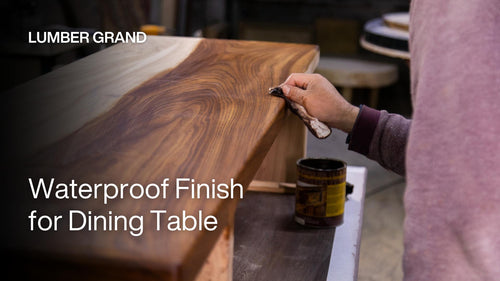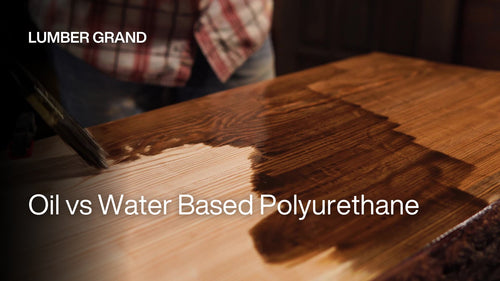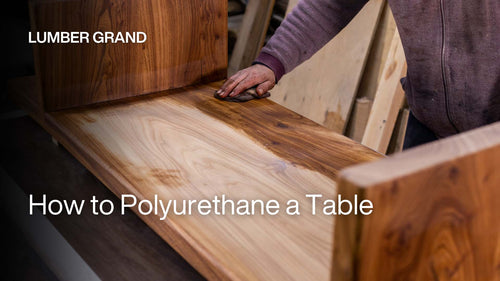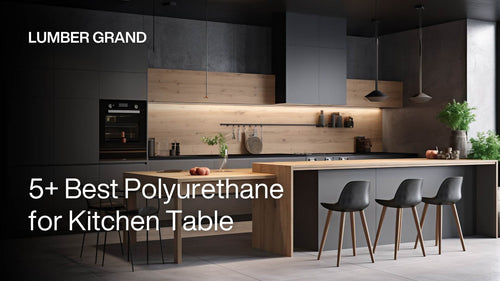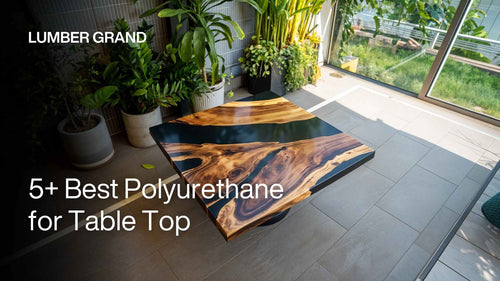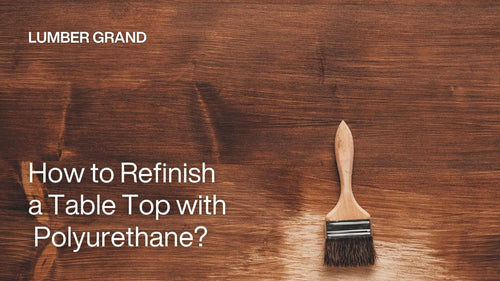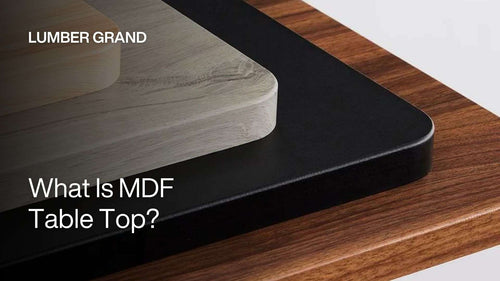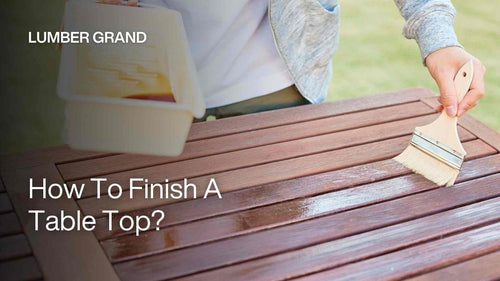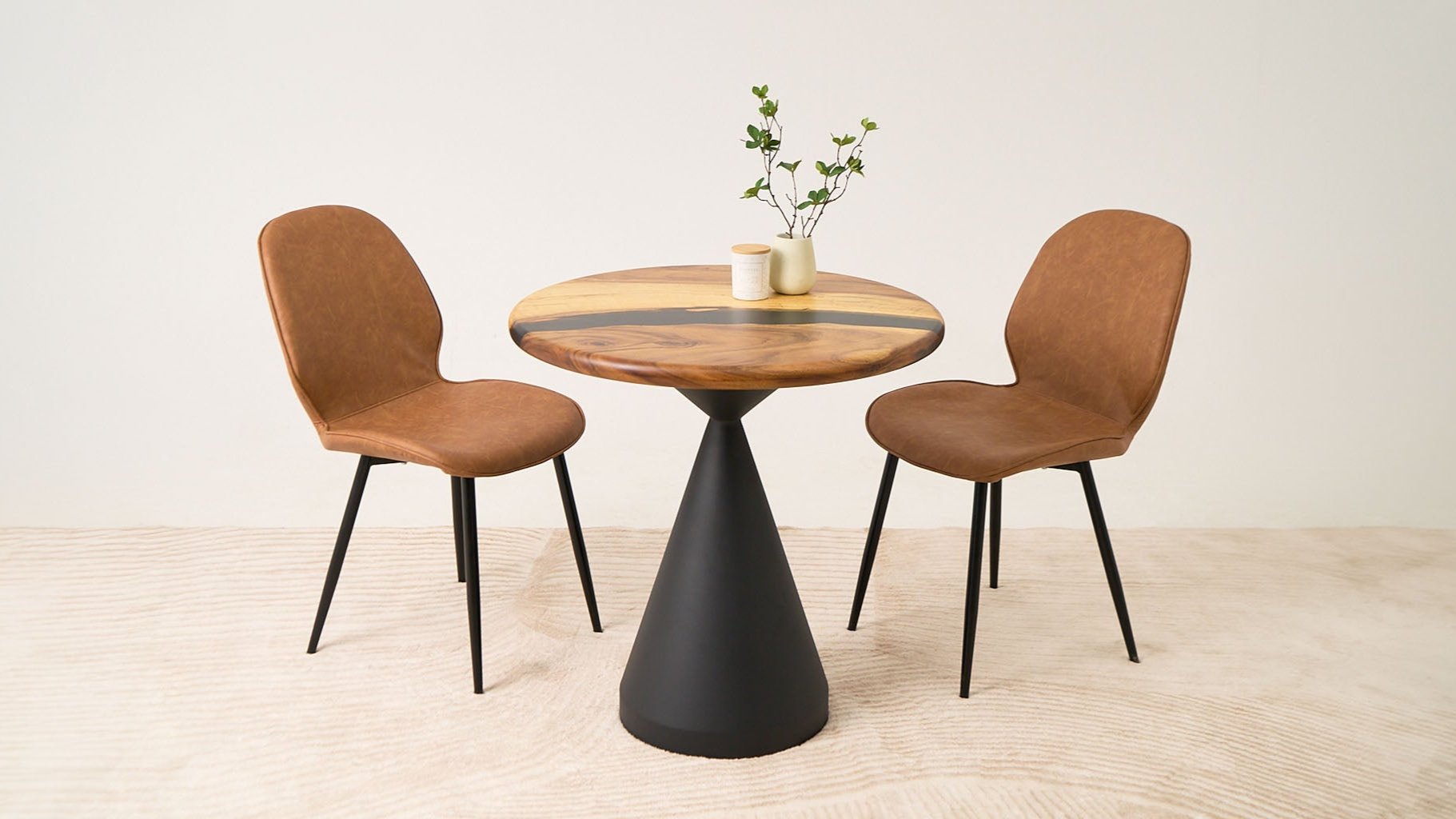Oil vs water based polyurethane both have their pros and cons, from dry time and hardness to how they bring out the natural tone of your wood.
-
Oil-based gives you that classic amber glow and superior toughness, but comes with strong fumes and long drying times.
-
Conversely, water-based keeps your wood's natural color, dries fast, and won't stink up your house. Yet, it costs more and might need extra coats.
In this guide, Lumber Grand breaks down everything you need to know about water based vs oil based polyurethane in detail. You'll know which one works best for your wood, how to apply each type, and more. So, is water based or oil based polyurethane better? Read more!
Oil vs Water Based Polyurethane: Quick Comparison Table
Here is a quick overview table between oil based vs water based polyurethane based on key factors like drying time, cost, durability, and application requirements to consider.
This way, it will be easier to reference water vs oil based polyurethane back when you need it. Besides, if one of them suits your needs, then simply scroll down to learn more about its overview, pros, cons, as well as its application tips!
|
Feature |
Water-Based Polyurethane |
Oil-Based Polyurethane |
|
Appearance & Color |
Clear finish, maintains natural wood color |
Amber/yellow tint that darkens over time |
|
Drying Time Between Coats |
2 — 4 hours |
6 — 10 hours |
|
Touch Dry Time |
2 — 4 hours |
6 — 10 hours |
|
Ready for Light Foot Traffic |
24 hours |
24 — 48 hours |
|
Ready for Furniture |
48 — 72 hours |
48 — 72 hours |
|
Number of Coats Needed |
3 coats (1 sealer + 2 finish) |
2 — 3 coats |
|
Price per Gallon |
$40 — $80 |
$30 — $50 |
|
Coverage per Gallon |
500 — 600 sq ft |
400 — 500 sq ft |
|
Cleanup Method |
Soap and water |
Mineral spirits/paint thinner |
|
Odor Level |
Very low, minimal smell |
Strong, pungent odor |
|
Safe to Stay in House |
Yes, during application |
No, evacuate for 2 — 3 days |
|
Environmental Impact |
Low VOCs, eco-friendly |
High VOCs, stronger fumes |
|
Durability |
Harder surface, more scratch-prone |
Softer surface, more dent-prone |
|
Application Difficulty |
Harder (fast-drying, requires skill) |
Easier (longer working time) |
|
Finish Quality |
Slightly rougher texture |
Smoother, silkier feel |
|
Maintenance |
Easier to repair scratches |
More resistant to daily wear |
|
Best For |
Light woods, quick projects, families with children/pets |
Dark woods, high-traffic areas, DIY projects |
Note: All drying times for oil vs water based polyurethane listed are between coats under ideal conditions (70°F and 50% humidity). Drying times can vary depending on temperature, humidity, and film thickness.
Read more: Best Polyurethane for Table Top
What is Water Based Polyurethane?
Water-based polyurethane is a clear wood finish that protects your furniture and floors without changing how the wood looks. Unlike older oil-based finishes that use oils or harsh chemicals, water-based polyurethane wood finish uses water to carry the protective ingredients.
When you brush it on, the water evaporates fairly quickly. The result you’ll get is a hard, transparent finish to protect your wood from scratches, spills, and regular use.

Water based polyurethane dries completely clear without adding color
Photo: Shutterstock
How water based polyurethane works: The protective ingredients (polyurethane resins) float around in water before you apply them to your wood. Once it's on there, the water evaporates rather quickly and leaves the resins glued to the wood to form a hard shell and protect everything beneath it.
Hence, water-based poly is a lot faster to dry than oil-based poly, where oil has to cure and take hours, as compared to water, which literally just disappears.
1. Pros of Water Based Polyurethane
-
Fast drying time for multiple coats a day: Because it dries so fast in just 2 — 4 hours, you can apply a sealer coat and two finish coats all in the same day.
-
Low VOCs and safer: Water-based polyurethane has almost no smell and is much safer to breathe. You can comfortably stay in your house while applying it, and it's safe around kids and pets. Also, you don’t have to wear masks or open all the windows like with oil-based finishes.
-
Preserves wood's natural color: Water-based poly stays crystal clear and just slightly turns yellow over time. As a result, it's ideal for light woods like maple or any white, gray, or bleached finishes.
-
Higher durability: Water-based polyurethanes create a tough finish that handles scratches, furniture scuffs, and even pet claws really well.
-
Easy to clean: You can easily wash it with soap and water instead of harsh chemicals.
-
Environmentally friendly: Lower VOC content means it's better for indoor air quality and the environment. Water based polyurethane meets most green building standards and eco-friendly home requirements.
2. Cons of Water Based Polyurethane
-
More expensive: When comparing oil vs water based polyurethane, water poly will set you back $40 — $80/gallon in comparison to $20 — $40 for oil-based finishes.
-
Three coatings at least: Because you'll typically need 3 coats (1 sealer + 2 finish) instead of 2 to get the same oil protection. This means more time, more materials, and more chances for things to go wrong.
-
Difficult to apply for beginners: That fast drying time can actually work against you if you're not experienced. You‘ll have to work fast and smoothly, or you could end up with bubbles, streaks, and brush marks.
-
Scratch-prone surfaces: When fully cured, the water based poly finish is hard, but small scratches and scuff marks appear more easily than an oil-based finish would.
-
Wood won't look richer: Water-based poly keeps everything looking natural, but it doesn't enhance or enrich the wood grain at all.
What is Oil Based Polyurethane?
Oil-based polyurethane is the traditional wood finish that's been protecting furniture and floors for decades. Instead of using water like the newer finishes, it relies on oil and solvents to carry the protective ingredients.
Once applied to wood, oil-based poly creates a tough, amber-colored coating. It’s well-known for protecting your wood from scratches, spills, and heavy use, and actually makes the wood look richer and more beautiful.

Oil based polyurethane adds warm, golden tones to wood
Photo: Timberwolf
How oil based polyurethane works: The protective resins float around in petroleum-based solvents and oils instead of water. So, when you apply it, those solvents take their sweet time evaporating, which gives the finish a chance to spread out evenly and settle into a perfectly smooth surface.
Some of it even soaks slightly into the wood itself and then creates a deeper bond. This slow-drying process is why oil-based poly gives you more time to work with it. It’s also why the final result looks so smooth and professional — the finish literally has time to level itself out before it hardens.
1. Pros of Oil Based Polyurethane
-
Budget-friendly option: Oil-based polyurethane usually costs $30 — $40 per gallon, whereas water-based polyurethane is typically 2x the price.
-
Fewer coats needed: Oil-based poly usually requires only 2 — 3 coats to achieve full protection, compared to 3 coats with water-based polyurethane.
-
Durability: Oil-based polyurethane is famous for being tougher and lasting longer, especially on heavily used surfaces. Not to mention, oil-based versions are thicker and more resistant to damage than water-based polyurethane.
-
Brings out warm wood tones: Oil-based polyurethane gives a warm amber hue to enhance the wood grain and create the classic "honey" finish. It’s best to go with this finish if you want to highlight the natural golden tones of woods such as Fir, Ash, or Pine.
-
Beginner-friendly application: Slower drying time (6 — 10 hours) gives you plenty of time to work, fix mistakes, and achieve a smooth finish. Therefore, it’s much more forgiving for DIYers.
-
Self-leveling polyurethane: The longer working time allows the finish to flow nicely into a smooth surface as it levels out by itself. This means that oil-based polyurethane doesn’t demand any special techniques to remove brush marks.
-
Better scratch resistance: The softer surface hides minor scratches and scuffs better than harder finishes. Hence, it maintains its appearance longer.
2. Cons of Oil Based Polyurethane
-
Long dry time: You're looking at 6 — 10 hours between coats, and you can only apply 1 coat/day. A simple project that could be done in one day with water-based finish will take you 3 — 5 days with oil-based finish.
-
Strong smell and high VOC: Oil-based polyurethane has a strong smell and is high in VOC content, which might be harmful to breathe. Hence, we always ask our audience to wear a mask and leave the garage with their pets until it dries.
-
Color change of wood stain: That amber tint keeps getting darker over time. If you love the natural color of maple or any light wood, oil-based poly will permanently change your table to something you might not like years down the road. And the only way is to refinish table top again.
-
Difficult cleanup: Forget soap and water, you'll need mineral spirits or paint thinner to clean your brushes and tools.
-
Limited application windows: High humidity, extreme temperatures, or even a little moisture in the air can ruin your finish. You're basically at the mercy of the weather forecast, which can delay your project for days or weeks.
-
Environmental impact: Those VOC emissions contribute to air pollution and don't meet most green building standards. Therefore, if you care about the environment or need eco-friendly materials, oil-based poly isn't the answer.
Best Uses for Oil vs Water Based Polyurethane
Comparing water based vs oil based polyurethane really matters most for your specific project. Both have their sweet spots where they work best, so think about your priorities:
-
Do you want natural wood color or rich amber tones?
-
Can you handle strong fumes, or do you need something family-friendly?
-
Are you in a hurry, or can you take your time?
Here's when oil based vs water based poly makes the most sense, especially if you're trying to pick the best polyurethane for floors:
You might like: Best Polyurethane for Kitchen Table
1. Best Uses for Oil-based Poly
“Oil-based poly works best when you need superb durability and don't mind the extra time and hassle that comes with it.”
-
High-traffic hardwood floors: Busy family homes, stores, or office spaces benefit from oil-based poly's superior toughness. It handles heavy foot traffic, dropped items, and daily wear better than anything else.
-
Rich, Dark Woods: Dark wood species like walnut, cherry, mahogany, and oak look absolutely gorgeous under oil-based poly. That amber glow makes the wood look richer and more expensive than it actually is.
-
DIY weekend projects: Your projects go smoother with oil-based poly because you have time to fix mistakes before it dries. It’s ideal for beginners who want to refinish furniture, cabinets, or smaller wood projects without the pressure of working fast.
-
Traditional or rustic decor: These styles benefit from that warm "honey" wood look that oil-based poly creates. It matches farmhouse, traditional, and vintage interior styles perfectly.
-
Big projects on tight budgets: They work well with oil-based poly since it costs about half what water-based finishes do.
-
Heavy-use furniture: Table tops and other furniture that sees daily wear, spills, etc.
-
Vintage and antique work: Restoration and antique projects often need oil-based finishes to maintain that authentic look and match the original finishes that were used decades ago.

Oil-based poly works great when you self-leveling polyurethane for table tops
Photo: Freepik
2. Best Uses for Water-based Poly
“Water-based poly is your best bet when you need clean results fast, especially if you want to keep your wood's natural color or can't deal with toxic fumes.”
-
Light-colored wood floors: Maple, ash, pine, birch, or any blonde or whitewashed woods look stunning with the best water based polyurethane for floors,
-
Quick turnaround projects: These projects work perfectly with water-based poly. You can get multiple coats done and be back in business within 24 hours.
-
Modern and contemporary decor: Decor styles need that clean, natural wood color to maintain their original and minimalist look.
-
Eco-conscious projects: Water-based poly is suitable for green building projects, LEED certification requirements, or homeowners who prioritize environmental responsibility and indoor air quality.
-
Stairs and railings: You apply multiple coats in one day and use the stairs again within 24 hours.
-
White, gray, or painted wood finishes: They need water-based poly to maintain their intended color without the yellowing or amber tinting that would completely ruin the designed appearance.
-
Health-sensitive individuals: Anyone with asthma, allergies, or chemical sensitivities should stick with water-based poly since they simply can't tolerate the strong fumes that come with oil-based products.

Water-based poly is your best bet when you need clean results fast
Photo: Freepik
Application Technique: Oil vs Water Based Polyurethane
The way you apply polyurethane oil vs water based is completely different, and understanding those differences is key to getting good results with either one.
- Water-based polyurethane application: Water-based polyurethane requires efficient work due to its fast drying time of 2 — 4 hours between coats. You should use synthetic brushes or foam rollers and apply the finish in manageable 2 — 3 foot sections. It's important to apply thin, even coats. Sand lightly between coats, and you're ready to walk on it in 24 hours.
- Oil-based polyurethane application: Oil-based poly is more forgiving with timing than water based polyurethane. You have 6 — 10 hours of working time, so you can take your time getting it right. In case of oil version, you should use natural bristle brushes for the work. Between coats, you'll wait 6 — 10 hours (or overnight). The surface needs 24 — 48 hours before light foot traffic
Read more: How to Polyurethane a Table
FAQs
1. Can You Apply Water-based Polyurethane Over Oil-Based Stain?
Yes, many professionals note that it’s possible to apply water-based polyurethane over oil-based stains.
However, you must allow the oil-based stain to dry for 8 — 24 hours minimum, then test it by wiping it with mineral spirits. If no color comes off, it's ready. However, we recommend waiting 72 hours or even up to a week for complete curing to prevent adhesion failures.
2. How Many Coats of Polyurethane Do I Need?
The number of coats of polyurethane between water vs oil based polyurethane depends on the type of product, and usage:
-
Water-based polyurethane: It generally needs 3 — 4 coats due to lower solids content (30 — 35%).
-
Oil-based polyurethane: Requires 2 — 3 coats minimum, with 3 coats being standard. This is because oil-based products contain 45 — 50% solids. That’s why it can create more protective coverage per coat. In areas with heavy traffic or large pets, we always recommend 3 — 4 coats.
3. What is the Best Type of Polyurethane to Use?
There is no "best" polyurethane for all applications, since your needs, lifestyle, and personal choices determine the best one.
-
Water-based is popular because it dries fast, has no smell, and keeps wood's natural color without yellowing. But it costs more.
-
On the other hand, oil-based is known for being tougher, more impact-resistant, and creating richer finishes with fewer coats needed.
4. Is Water-Based Polyurethane Good for Wood?
Yes, water-based polyurethane is one of the best finishes for wood. It's hard and durable, resists dents well, but might show fine scratches more than oil-based poly. However, you can find modern versions of water based that are nearly as tough as oil-based. Of course, it will come up with a higher price compared to oil based polyurethane.
Oil vs Water Based Polyurethane: Which One is Better?
Deciding on oil based polyurethane vs water based will depend on your project priorities. Both have pros and cons, so pick carefully.
Choose water-based polyurethane if:
-
You need a fast drying time to complete the work in one day.
-
You prefer minimal odor and low VOC content for indoor air safety, especially when there are children or pets present.
-
You wish the wood to keep its natural color and not turn yellow over time.
-
You are dealing with light-colored, bleached, white-stained, or gray woods.
-
You require a water-cleanable finish.
Choose oil-based polyurethane if:
-
You consider durability and a thicker finish (although today's water-based polyurethanes are also very durable).
-
You want a finish that brings out the warm amber tones and highlights the natural wood grain, especially on woods like Fir, Ash, or Pine.
-
You have a tighter budget for initial material costs.
At the end of the day, you know your project better than anyone else. So, use your best judgment to decide if oil vs water based polyurethane works best for you. For additional advice and furniture maintenance tips, be sure to visit the Lumber Grand blogs. Thank you for reading!




